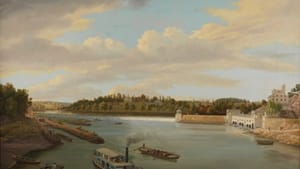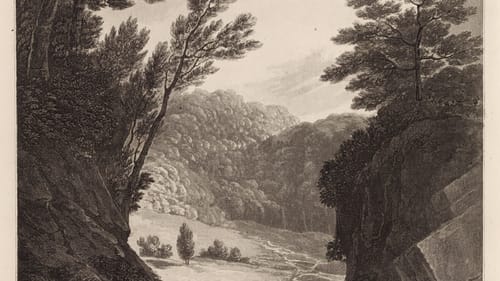Stay in the Loop
BSR publishes on a weekly schedule, with an email newsletter every Wednesday and Thursday morning. There’s no paywall, and subscribing is always free.
When Philly was America
PAFA presents ‘From the Schuylkill to the Hudson: Landscapes of the Early American Republic’

When America was new, the world envisioned the country from a Philadelphia perspective. In From the Schuylkill to the Hudson: Landscapes of the Early American Republic, the Pennsylvania Academy of Fine Arts (PAFA) presents views that are still familiar in the local landscape but that, in the late 18th century, represented the nation for those who would never cross the Atlantic.
Philadelphia was the American city, and its waters and wilderness, from the Delaware waterfront to the Wissahickon Valley and beyond, were reproduced as prints, books, and tableware. The city’s preeminence was soon eclipsed as New York became the epicenter of business and culture. The exhibit’s title refers both to the Hudson River School of landscape painting, which celebrated the American wilderness, and to the use of water as visual reference—an approach that originated on the banks of the Schuylkill.
From reference to status symbol
The earliest American landscapes were utilitarian, topographical drawings made by the military, gallery notes explain, and for that reason have a distinctly British heritage. George Beck’s Schuylkill Below the Falls (c. 1798), a watercolor painted from what is now East Falls, may be the earliest recorded view of the river. Beck, a draftsman, focused on natural elements, but provided hints of human life: two fishermen the size of fingernail clippings.
The Birches, father William Russell and son Thomas, are well represented. William Birch immigrated to Philadelphia from England in 1794, a successful engraver who possessed the British appreciation for artful landscapes. Within a few years, he’d purchased Springland, a four-acre property in Bucks County that became a natural laboratory where he created allées, clearings, and glens to reproduce on paper.
Springland: The Artist’s Residence (after 1798), an enamel on copper brooch, sits in a case next to Arch Street Ferry (1801), a watercolor on ivory. Tiny and exquisite, the works are colorful and sharply detailed. Arch Street is a dockside scene of a sailing ship webbed in rigging, with an American flag billowing from the stern, a world in a space the size of two fingers.

Better homes and gardens
Nature dominates in early landscapes. People are generally absent or incidental specks. The shift began when artists set formal portraits outdoors, as in Charles Willson Peale’s John Dickinson (1770), or family groupings by James Peale and Jacob Eichholtz.
In many works the landscape surrounds an impressive home, a tactic that enabled artists to cultivate wealthy patrons, as William Birch did in his book The Country Seats of the United States of North America (1808). The title page is suitably august: It features a soaring eagle gripping the stars and stripes in its talons and calligraphy worthy of the Declaration of Independence.
Thomas Birch’s The Residence of James Craig, Bristol, Pennsylvania, as seen from the Delaware (c. 1820-22) shows a well-dressed party of six crammed into a rowboat meant for four, floating before a temple-like mansion. Perhaps they were set adrift by Mr. Craig in order to enjoy the best view of his columns and portico.
Big nature, little humans
In Fairmount Water Works (1821), Thomas Birch created a quintessential picture of Philadelphia, a much-copied image that PAFA first exhibited in 1824. We look up the Schuylkill, the city behind us. The water works, which revolutionized the delivery of potable water to city-dwellers and became an international sensation, hug the right bank. Lemon Hill perches on a distant rise. The then-new dam cuts across the river, dividing the painting into layers of active earth and placid sky. A flotilla of pleasure craft crowds the foreground, including the first steamship to travel up the Schuylkill, ferrying passengers on two decks, as well as a rowboat that’s just set off, and in the center of the river, a boatload of rowers being urged on by a coxswain.

In contrast to the Birches, Joshua Shaw examined the opposite end of the residential spectrum. Landscape with Farmhouse and Castle (1818) observes a humble homestead where cows and geese amble along the edge of a pond under an expansive sky. Shaw’s style was emulated by John Hill in several works here, including View Near the Falls of Schuylkill (1820), a remarkable etching of a man leading a horse through a towering crevasse. A lost lamb is draped across the horse. Sunlight filters through heavy cloud, lighting the small figures as they pick their way through steep terrain, water swirling in the middle distance. The ground, trees, rock walls, and even cloudbanks heave inward and down, as though being sucked into a vortex created by the falls.
Made in Philadelphia
The painters who carried the American landscape tradition north retained a strong Philadelphia connection. Thomas Cole, regarded as the founder of the Hudson River School, lived and trained here, as did Thomas Doughty, who bequeathed Landscape with Curving River (c. 1823) and two other works to PAFA at his death in 1856. Both artists are on view here, along with numerous other notables of the American landscape tradition.
The exhibit, consisting mostly of work drawn from PAFA’s collection, underscores the heritage of the institution in cultivating and exhibiting American art. Curated by Dr. Anna O. Marley, Schuylkill to Hudson can be appreciated superficially, as a refreshing retreat from hot cityscapes, or more deeply, as a technical achievement by artists and those who preserve historic works, as demonstrated in a short but fascinating gallery video of the restoration of Russell Smith’s Mahanoy Mountain on the Susquehanna (1840), featuring PAFA painting conservator Mary McGinn.
Local viewers can appreciate the exhibit for the history it documents, opening a window on Philadelphia’s post-fireworks phase, when it was the new nation’s source not only of political invention but of artistic inspiration as well.
What, When, Where
From the Schuylkill to the Hudson: Landscapes of the Early American Republic. Through December 29, 2019, at the Pennsylvania Academy of Fine Arts, Samuel M.V. Hamilton Building, 128 North Broad Street, Philadelphia. (215) 972-7600 or www.pafa.org.
PAFA galleries are accessible to wheelchairs and strollers through the Broad Street entrance of the Hamilton Building, which can be accessed by a button at the front. Staff will greet and assist visitors. Wheelchairs are available at no charge on a first-come basis at the front desk. Large-print materials are provided at the front desk. Tours for those with special needs are available on request. For more information, call (215) 972-2069. Personal care attendants are admitted without charge, and service animals are welcome.
Sign up for our newsletter
All of the week's new articles, all in one place. Sign up for the free weekly BSR newsletters, and don't miss a conversation.
